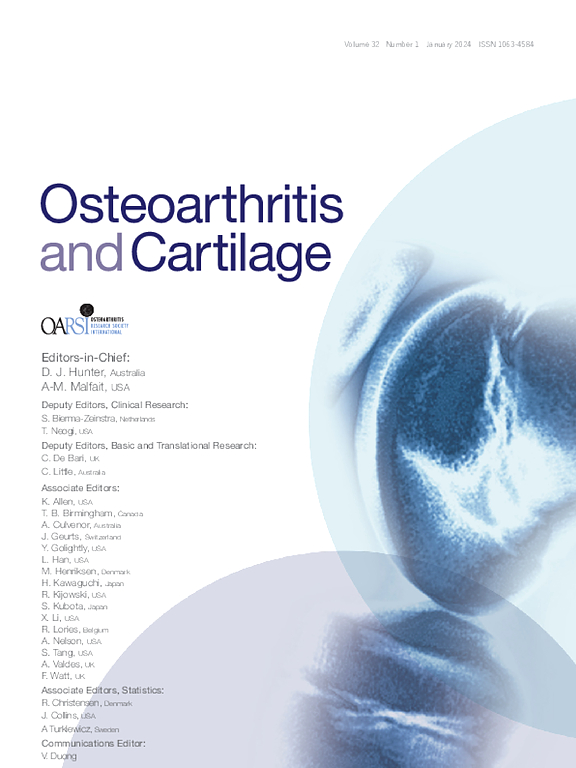A major functional role of synovial fluid is to reduce the rate of cartilage fatigue failure under cyclical compressive loading
IF 7.2
2区 医学
Q1 ORTHOPEDICS
引用次数: 0
Abstract
Objective
Based on our recent study, which showed that cartilage fatigue failure in reciprocating sliding contact results from cyclical compressive forces, not from cyclical frictional forces, we hypothesize that a major functional role for synovial fluid (SF) is to reduce the rate of articular cartilage fatigue failure from cyclical compressive loading.
Design
The rate of cartilage fatigue failure due to repetitive compressive loading was measured by sliding a glass lens against an immature bovine cartilage tibial plateau strip immersed in mature bovine SF, phosphate-buffered saline (PBS), or SF/PBS dilutions (50% SF and 25% SF; n = 8 for all four bath conditions). After 24 h of reciprocating sliding (5400 cycles), samples were visually assessed, and if damage was observed, the test was terminated; otherwise, testing was continued for 72 h (16,200 cycles), with solution refreshed daily.
Results
All eight samples in the PBS group exhibited physical damage after 24 h, with an average final surface roughness of Rq= 0.210 ± 0.067 mm. The SF group showed no damage after 24 h; however, two of eight samples became damaged after 72 h, producing a significantly lower average surface roughness than the PBS group (Rq=0.059 ± 0.030 mm; p < ). For the remaining groups, at 72 h, one of eight samples was damaged in the 50% SF group, and five of eight samples were damaged in the 25% SF group.
Conclusions
The results strongly support our hypothesis, showing that decreased amounts of SF in the testing bath produce increased rates of fatigue failure in cartilage that was subjected to reciprocating sliding contact.
滑液的一个主要功能作用是降低软骨在周期性压缩负荷下的疲劳破坏率。
目的:我们最近的研究表明,软骨在往复滑动接触中的疲劳破坏是由周期性压缩力而非周期性摩擦力造成的,基于这一研究,我们假设滑液(SF)的一个主要功能作用是降低周期性压缩负荷造成的关节软骨疲劳破坏率:设计:通过用玻璃透镜对浸泡在成熟牛滑膜液、磷酸盐缓冲盐水(PBS)或滑膜液/PBS稀释液(50%滑膜液和25%滑膜液;所有四种浸泡条件下的人数均为8)中的未成熟牛软骨胫骨平台条进行滑动,测量重复压缩负荷导致的软骨疲劳破坏率。经过 24 小时的往复滑动(5,400 个循环)后,对样品进行目测评估,如果观察到损坏,则终止测试;否则,继续测试 72 小时(16,200 个循环),每天刷新溶液:结果:PBS 组的所有八个样品在 24 小时后都出现了物理损坏,平均最终表面粗糙度为 Rq=0.210±0.067 毫米。SF 组在 24 小时后没有出现损坏;但是,8 个样品中有 2 个在 72 小时后出现损坏,产生的平均表面粗糙度明显低于 PBS 组(Rq=0.059±0.030 毫米;p-4)。其余各组中,72 小时后,50% SF 组的八个样品中有一个损坏,25% SF 组的八个样品中有五个损坏:结果有力地支持了我们的假设,即测试浴中 SF 含量的减少会增加软骨在往复滑动接触中的疲劳破坏率。
本文章由计算机程序翻译,如有差异,请以英文原文为准。
求助全文
约1分钟内获得全文
求助全文
来源期刊

Osteoarthritis and Cartilage
医学-风湿病学
CiteScore
11.70
自引率
7.10%
发文量
802
审稿时长
52 days
期刊介绍:
Osteoarthritis and Cartilage is the official journal of the Osteoarthritis Research Society International.
It is an international, multidisciplinary journal that disseminates information for the many kinds of specialists and practitioners concerned with osteoarthritis.
 求助内容:
求助内容: 应助结果提醒方式:
应助结果提醒方式:


